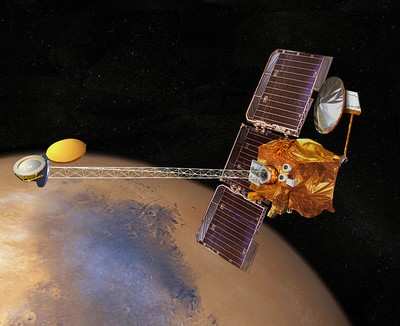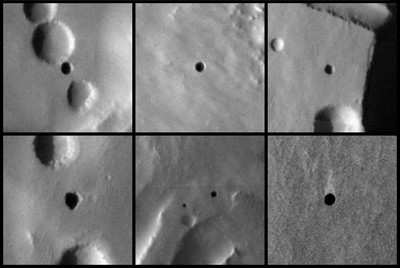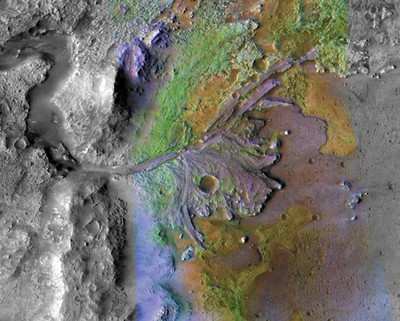Change In Orbit Should Reveal New Data About The Red
Planet
NASA's long-lived Mars Odyssey spacecraft has completed an
eight-month adjustment of its orbit, positioning itself to look
down at the day side of the planet in mid-afternoon instead of late
afternoon.

This change gains sensitivity for infrared mapping of Martian
minerals by the orbiter's Thermal Emission Imaging System camera.
Orbit design for Odyssey's first seven years of observing Mars used
a compromise between what worked best for the infrared mapping and
for another onboard instrument.
"The orbiter is now overhead at about 3:45 in the afternoon
instead of 5 p.m., so the ground is warmer and there is more
thermal energy for the camera's infrared sensors to detect," said
Jeffrey Plaut of NASA's Jet Propulsion Laboratory, Pasadena, CA,
project scientist for Mars Odyssey.
Some important mineral discoveries by Odyssey stem from mapping
done during six months early in the mission when the orbit geometry
provided mid-afternoon overpasses. One key example: finding salt
deposits apparently left behind when large bodies of water
evaporated.

File Photo
"The new orbit means we can now get the type of high-quality
data for the rest of Mars that we got for 10 or 20 percent of the
planet during those early six months," said Philip Christensen of
Arizona State University, Tempe, principal investigator for the
Thermal Emission Imaging System.
Here's the trade-off: The orbital shift to mid-afternoon will
stop the use of one of three instruments in Odyssey's Gamma Ray
Spectrometer suite. The new orientation will soon result in
overheating a critical component of the suite's gamma ray detector.
The suite's neutron spectrometer and high-energy neutron detector
are expected to keep operating. The Gamma Ray Spectrometer provided
a dramatic 2002 discovery of water-ice near the Martian surface in
large areas. The gamma ray detector has also mapped global
distribution of many elements, such as iron, silicon and
potassium.
Last year, before the start of a third two-year extension of the
Odyssey mission, a panel of planetary scientists assembled by NASA
recommended the orbit adjustment to maximize science benefits from
the spacecraft in coming years.
On Sept. 30, 2008, Odyssey fired thrusters for six minutes,
putting the orbiter into a "drift" pattern of gradually changing
the time-of-day of its overpasses during the next several
months. On June 9, Odyssey's operations team at JPL and at
Denver-based Lockheed Martin Space Systems commanded the spacecraft
to fire the thrusters again. This five-and-a-half-minute burn ended
the drift pattern and locked the spacecraft into the mid-afternoon
overpass time.

File Photo
"The maneuver went exactly as planned," said JPL's Gaylon
McSmith, Odyssey mission manager.
In another operational change motivated by science benefits,
Odyssey has begun in recent weeks making observations other then
straight downward-looking. This more-flexible targeting allows
imaging of some latitudes near the poles that are never directly
underneath the orbiter, and allows faster filling-in of gaps not
covered by previous imaging.
"We are using the spacecraft in a new way," McSmith said.
In addition to extending its own scientific investigations, the
Odyssey mission continues to serve as the radio relay for almost
all data from NASA's Mars Exploration Rovers, Spirit and
Opportunity. Odyssey's new orbital geometry helps prepare the
mission to be a relay asset for NASA's Mars Science Laboratory
mission, scheduled to put the rover Curiosity on Mars in 2012.
 ANN's Daily Aero-Linx (04.16.24)
ANN's Daily Aero-Linx (04.16.24) Aero-News: Quote of the Day (04.16.24)
Aero-News: Quote of the Day (04.16.24) Airborne 04.10.24: SnF24!, A50 Heritage Reveal, HeliCycle!, Montaer MC-01
Airborne 04.10.24: SnF24!, A50 Heritage Reveal, HeliCycle!, Montaer MC-01 Airborne 04.12.24: SnF24!, G100UL Is Here, Holy Micro, Plane Tags
Airborne 04.12.24: SnF24!, G100UL Is Here, Holy Micro, Plane Tags Airborne-Flight Training 04.17.24: Feds Need Controllers, Spirit Delay, Redbird
Airborne-Flight Training 04.17.24: Feds Need Controllers, Spirit Delay, Redbird





